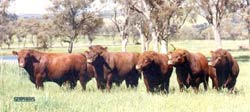
Cattle breeds: Shorthorn
Origin
The Shorthorn originated in the north-eastern part of England in the 1700s (where they were originally known as ‘Durhams’), having evolved from a race of superior short-horned cattle known to have existed in the area since the 16th century. In the middle 1800s, Scottish breeders selected animals that had increased compactness, thickness and the ability to mature and fatten at an early age, resulting in the present-day Shorthorn breed.
The breed was one of the first purebred breeds to be introduced into Australia. It was introduced into New South Wales in the late 18th century. The breed has a wide genetic base, resulting in the development of several distinct though closely related strains — these are the traditional strains:
- Beef Shorthorn
- Poll Shorthorn
- Durham
- Dairy Shorthorn
- Australian Shorthorn
The current Shorthorn Society of Australia encompasses the Poll Shorthorn, Australian Shorthorn and the Durham.
Distribution
The Shorthorn was originally established in the temperate, more reliable rainfall areas, but by 1890 its beef genetics accounted for 50% of the cattle in temperate climates and 100% of cattle running in difficult northern environments.
The introduction of Bos Indicus and European breeds in more recent years has seen a decline in Shorthorn numbers in the north, but the breed is still found throughout most areas of Australia under most climatic and environmental conditions.
Breed characteristics

Shorthorns are a distinctive red, white or roan in colour, and can be polled or horned. The wide genetic base results in differing maturity patterns, enabling producers to select the Shorthorn type best suited to their environment and market. They have high fertility and good mothering ability, and generally have a docile temperament. They finish readily on good quality pastures and are noted for their good marbling characteristics when finished on grain.
In 1999 the Shorthorn Society of Australia established a research and development facility near Orange to enhance the advancement of the beef industry using principally Shorthorn genetics. Called Durham Research and Development Pty Ltd, the facility aims to provide the beef industry with an extension, learning and training facility that focuses on improving understanding of aspects of beef production.
Shorthorn Group BREEDPLAN
Shorthorn Group BREEDPLAN provides commercial and seedstock producers with the opportunity to be part of an across-herd genetic evaluation.
Further information
Further information is available from:

Shorthorn Society of Australia
PO Box 601
Armidale NSW 2350
Web: www.shorthorn.com.au
Acknowledgment
The author thanks the Shorthorn Society of Australia for their assistance in preparing this Agfact. Photos courtesy of the Shorthorn Society of Australia.

